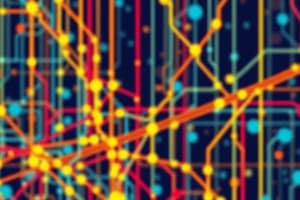Podcast
Questions and Answers
What role do packets serve in a computer network?
What role do packets serve in a computer network?
- They act as a means of transportation through the network. (correct)
- They provide the physical connection between devices.
- They manage the protocols used for communication.
- They represent the format of the information being sent.
Which two protocols are considered the most important for Internet communication?
Which two protocols are considered the most important for Internet communication?
- File Transfer Protocol (FTP) and Simple Mail Transfer Protocol (SMTP)
- Hypertext Transfer Protocol (HTTP) and Internet Control Message Protocol (ICMP)
- Secure Sockets Layer (SSL) and Transport Layer Security (TLS)
- Transmission Control Protocol (TCP) and Internet Protocol (IP) (correct)
What is a protocol in the context of internet communication?
What is a protocol in the context of internet communication?
- A hardware component that facilitates connection to the network.
- A set of rules determining the physical structure of the network.
- A specification for the content and handling of messages exchanged between entities. (correct)
- A secured method for data encryption during transmission.
Why do communicating entities need to run the same protocol?
Why do communicating entities need to run the same protocol?
What analogy is used to describe packet switches in a network?
What analogy is used to describe packet switches in a network?
What is the primary function of a protocol in network communications?
What is the primary function of a protocol in network communications?
Which of the following statements accurately describes DSL technology?
Which of the following statements accurately describes DSL technology?
In a network context, what are 'hosts' typically divided into?
In a network context, what are 'hosts' typically divided into?
What is the purpose of the DSLAM in a DSL network?
What is the purpose of the DSLAM in a DSL network?
How does the DSL technology achieve simultaneous internet and telephone service?
How does the DSL technology achieve simultaneous internet and telephone service?
What distinguishes asymmetric access in DSL?
What distinguishes asymmetric access in DSL?
Which of these mediums is NOT typically associated with DSL technology?
Which of these mediums is NOT typically associated with DSL technology?
What is a characteristic of the digital subscriber line (DSL) service?
What is a characteristic of the digital subscriber line (DSL) service?
What is a key difference between packet switching and circuit switching regarding resource allocation?
What is a key difference between packet switching and circuit switching regarding resource allocation?
What aspect of circuit switching is considered wasteful by proponents of packet switching?
What aspect of circuit switching is considered wasteful by proponents of packet switching?
If a user is active 10 percent of the time, what is the probability that there are 11 or more simultaneously active users among 35 users?
If a user is active 10 percent of the time, what is the probability that there are 11 or more simultaneously active users among 35 users?
What does packet switching allow in terms of link transmission capacity?
What does packet switching allow in terms of link transmission capacity?
What is the primary focus of network security?
What is the primary focus of network security?
In circuit switching using TDM, how are time slots allocated?
In circuit switching using TDM, how are time slots allocated?
Which architectural paradigm is NOT commonly used in modern network applications?
Which architectural paradigm is NOT commonly used in modern network applications?
Why is establishing end-to-end circuits considered complicated in circuit switching?
Why is establishing end-to-end circuits considered complicated in circuit switching?
What role does a socket play in network communications?
What role does a socket play in network communications?
What fundamentally distinguishes the way circuit switching and packet switching handle transmission link usage?
What fundamentally distinguishes the way circuit switching and packet switching handle transmission link usage?
What is the primary advantage of packet switching highlighted in the content?
What is the primary advantage of packet switching highlighted in the content?
Which statement correctly describes TCP's congestion-control mechanism?
Which statement correctly describes TCP's congestion-control mechanism?
How do processes on different end systems typically communicate?
How do processes on different end systems typically communicate?
What is primarily under the control of the application developer within a socket?
What is primarily under the control of the application developer within a socket?
What is a significant difference between network architecture and application architecture?
What is a significant difference between network architecture and application architecture?
Which of the following is essential for the structure of an application over various end systems?
Which of the following is essential for the structure of an application over various end systems?
What does the total nodal delay in a packet-switched network consist of?
What does the total nodal delay in a packet-switched network consist of?
If the intensity of traffic is equal to 1, what does this indicate about the average packet arrival rate?
If the intensity of traffic is equal to 1, what does this indicate about the average packet arrival rate?
What typically happens to packets as they traverse multiple routers?
What typically happens to packets as they traverse multiple routers?
In a network environment, what occurs during the queuing delay?
In a network environment, what occurs during the queuing delay?
Which of the following best describes throughput in packet-switched networks?
Which of the following best describes throughput in packet-switched networks?
What is the relationship between packet arrival processes and queuing delays?
What is the relationship between packet arrival processes and queuing delays?
If a router shows an increasing round-trip delay for packet n compared to packet n+1, what could be inferred?
If a router shows an increasing round-trip delay for packet n compared to packet n+1, what could be inferred?
What is the formula for calculating intensity of traffic in a packet-switched network?
What is the formula for calculating intensity of traffic in a packet-switched network?
Flashcards are hidden until you start studying
Study Notes
What Is the Internet?
- The internet is a global network of interconnected computers
- It is a networking infrastructure that provides services to distributed applications
- The Internet can be described in terms of packets, communication links, packet switches, and end systems
- Packets are like trucks, communication links are like highways, packet switches are like intersections, and end systems are like buildings.
- The Internet offers a variety of services, including email, web browsing, file transfer, and video conferencing
- A protocol defines the format and order of messages exchanged between two or more communicating entities, as well as the actions taken on the transmission and/or receipt of a message or other event
- TCP/IP are two of the most important protocols in the Internet
The Network Edge
- End systems connect to the Internet through access networks such as DSL and FTTH
- A DSL modem translates digital data to high-frequency tones for transmission over telephone wires
- A DSLAM in the telco's central office translates analog signals back into digital format
- DSL supports both data and traditional telephone signals simultaneously at different frequencies
- Fiber-to-the-home (FTTH) offers high-speed connections directly to the home, bypassing the telco's central office
Access Networks
- DSL is a common access network that uses existing telephone lines
- FTTH offers high-speed connections directly to the home
- Cable networks use coaxial cables to connect homes to an ISP
- Satellite networks use radio waves to connect homes to an ISP
- Wireless networks use radio waves to connect devices to an ISP
- Cellular networks use radio waves to connect mobile devices to an ISP
Transmission Media
- Coaxial cable is a type of transmission media that uses a central conductor surrounded by an insulator and a braided shield
- Fiber optic cable is another type of transmission media that transmits data as light pulses, offering high bandwidth and low signal loss
- Radio channels use radio waves to transmit information, offering flexibility and wide coverage
- Wi-Fi, cellular, and satellite are types of radio channels
Network Core
- The network core contains routers connected by high-speed links
- Routers forward packets between networks
- Routers use packet switching to forward packets, meaning that packets are not assigned to a specific route until they are sent
- Packet switching is more efficient than circuit switching, because it allows for the sharing of network resources on demand
- The internet uses store-and-forward transmission, where the packet is received at a router, stored for a while, and then sent to a next router on the network
- The routing path for each packet is determined by the routing algorithms
Delay, Loss, and Throughput in Packet-Switched Networks
- Packet-switched networks introduce delays and losses due to network conditions, user demands, and bandwidth constraints
- The total nodal delay (d(node)) is the sum of processing delay, queuing delay, transmission delay, and propagation delay
- Processing delay is the time required for a router to process a packet
- Queuing delay is the time a packet waits in a queue before being processed
- Transmission delay is the time required to transmit the packet over the link
- Propagation delay is the time it takes for a signal to travel from the sender to the receiver
- Packet loss occurs when a router discards a packet because its queue is full or because of network errors
- Network throughput is the amount of data that can be transmitted per second
- The internet is designed to be resilient to packet loss
Protocol Layers
- Network protocols are layers of abstraction that define the format and order of messages exchanged between different communication entities
- The application layer handles network applications such as email, web browsing, and file transfer.
- The transport layer provides reliable data transfer, and handles segmentation and reassembly of messages.
- The network layer handles routing of packets.
- The link layer manages physical transmission of data over the network.
Network Security
- Network security is about protecting computer networks from malicious attacks
- Network attackers can disrupt or compromise network operations, steal sensitive information, or access restricted resources
The History of the Internet
- The internet evolved from a network of research computers into the global network we know today
- In the 1970s, the ARPANET and other networks were interconnected, forming the foundation for the internet
- In the 1980s, the TCP/IP protocol suite was adopted as the standard for the internet
- In the 1990s, the World Wide Web (WWW) was developed and the internet became widely accessible
- In the 2000s, the rise of mobile devices and social media further transformed the internet
- The internet continues to evolve at a rapid pace
Application Layer
- The application layer is responsible for providing services to network applications
- Two common application architectures are client-server and peer-to-peer
- Client-server architecture involves a client requesting services from a server
- Peer-to-peer architecture allows for direct communication between peers
- Network applications communicate by exchanging messages across the network
- Each network application uses specific protocols that define the format and the order of the messages exchanged
- A socket is an API that allows application processes to communicate with the network
- TCP is a transport layer protocol that provides reliable data transfer
- TCP includes congestion control mechanisms to prevent network congestion
- UDP is a transport layer protocol that provides unreliable data transfer
- UDP is a faster choice for applications that do not require reliable data transfer
- The principles of network application design are used to define the communication strategies between end systems, such as the message format, encoding and decoding of message, and the mechanism to ensure data integrity and reliability.
Studying That Suits You
Use AI to generate personalized quizzes and flashcards to suit your learning preferences.




